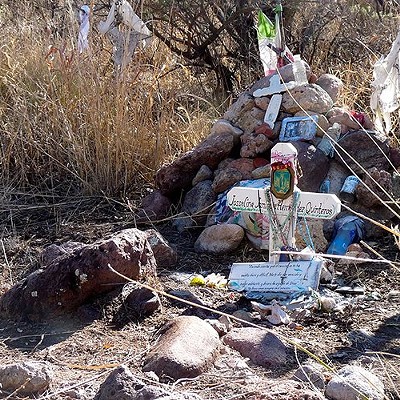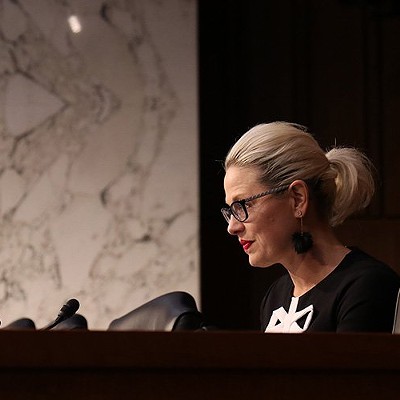You can't see Mexico from the Louise Foucar Marshall Building. But you feel it every day in this enclave of the UA Journalism Department.
Prodded by nervous campus administrators, journalism professors have ratcheted up their warnings to students about working in Mexico—a cautionary stance that sometimes strains the boundary between necessary reportage and excess caution.
For associate professor Maggy Zanger—whose profession has taken her to hotspots such as Iraq, where she ran the Institute for War and Peace Reporting—putting a leash on aggressive journalism goes against the grain. But she says Mexico's chaotic drug violence presents a new twist. "I've lived and worked in some pretty dodgy places, and I'm not one to be squeamish about these things. But I seriously don't know if I would want to go into Mexico.
"In (traditional) war zones, things are a little bit more predictable," she says. "The messy guerilla wars, where there really aren't any lines, are more dangerous than the standard stuff. Still, even there, you know whose territory is what. But with these drug cartels, it's totally unpredictable."
Over the last four years, drug violence in Mexico has claimed nearly 23,000 lives, and the carnage seems nowhere near abating; in March, gunmen, or sicarios, likely linked to the drug trade, even killed a U.S. Consulate staffer and her husband in Ciudad Juarez as they left a children's party. The spouse of another consulate employee was also killed.
It's believed that more Americans may be targeted as the United States continues to aid the Mexican government under the Mérida Initiative. Often referred to as "Plan Mexico," after a similar program in Colombia, the initiative pledged $1.4 billion in military and security aid to fight the narcotics cartels.
Violence common to Juarez has spread west to the fringes of Arizona; just last month, assassins killed the deputy police chief of Nogales, Sonora, and his bodyguard. That follows the November 2008 murder of Juan Manuel Pavón Félix, director of Sonora's state police, as he was entering a Nogales hotel.
Mexico also remains one of the world's most dangerous countries for journalists. According to the group Reporters Without Borders, more than 60 journalists have been murdered in that country since 2000.
Despite this bloodbath, students continue working south of the border—with a heavy dose of caution. Red flags went up, for instance, when several proposed a journey with migrants that would start in the raucous border town of Altar, Sonora, a popular launching pad for smugglers. "I strongly discouraged them from doing that," says UA journalism professor Jay Rochlin (and an occasional Weekly contributor). "I didn't think that was necessary, in order for them to be able to tell the migrants' story.
"It would have been an artificial situation, anyway," Rochlin says. "These students would have been wearing good hiking boots, and carrying cell phones and GPS (devices)." Unlike migrants, "somebody would have also come looking for the students if they hadn't shown up on time."
As a result, less-ambitious forays have become more common for students such as Curtis Prendergast. Last fall, he studied under Rochlin in a class that produces the online publication Border Beat. "I probably wrote three or four stories in Nogales, Sonora," Prendergast says. One was a profile about Radio XENY, a popular Mexican station known for its fairly solid reporting. "I went down there with a couple of other students, and everything we did was within a couple of blocks of the border. We didn't really venture too far into the city."
Cash-starved vendors who've seen business dwindle due to the violence provided the only harassment. "I have a feeling that a year or two ago, there were probably a lot more people there," Prendergast says. "We were the only targets for them for them to talk to. But they talked to us in a very nice way. They were offering us tequila if we went into their shops."
Prendergast lived for several years in Brazil and Argentina, so he boasted more familiarity with Latin America than most students. Nonetheless, news reports of violence did put him on edge. "Also, there is a lot of poverty directly across the border, and that made me a little bit nervous about crossing," he says, "because a lot of times, poverty is linked with crime."
At the same time, the UA was ratcheting up its own nervousness quotient. "From the university itself, we hear that it's very dangerous to go across the border, and that we should be very, very careful," he says. "The university is not going to prohibit us from crossing the border. But they're going to do everything they can to basically scare us away from crossing."
Assuming that some students will still follow stories to the other side, the school is also hedging its bets. The UA Journalism Department has begun talks with the Dart Center for Journalism and Trauma, a project of Columbia University's Graduate School of Journalism.
Meg Spratt is director of Dart Center West in Seattle. "For us, going out to universities is really pretty new," she says. "We have more than a decade of doing annual training for professional journalists through our fellowship program, but we're just launching fellowship programs for people who teach journalism."
The intensive training, which focuses on preparing reporters for jolting situations and traumatized victims, includes everyone "from psychiatrists to journalists who have dealt with some pretty terrible issues," says Spratt.
She learned firsthand how harrowing situations can scar young reporters. After graduating from the University of Southern California, where she "got absolutely no preparation in dealing with really tragic stories," Spratt landed a job covering the Los Angeles Police Department. "I found that I was going home shaky just after a regular shift," she recalls, "because there had been so much senseless injury and death that I had been exposed to."
Understanding the effects of such exposure is particularly critical, she says, as budding journalists—and their teachers—cope with an increasingly dangerous Mexico. "And in talking with Maggy Zanger and other (UA) professors, I've really heard a shift in that direction."
Back at the UA, Zanger says sending students to the border remains an increasingly delicate balancing act—which highlights the distinction between overreaction and common sense. "We're really concerned that they be safe, and we want them to be able to cover the border. We want them to have that experience. But also, as we used to say in Iraq, dead men can't tell stories."












